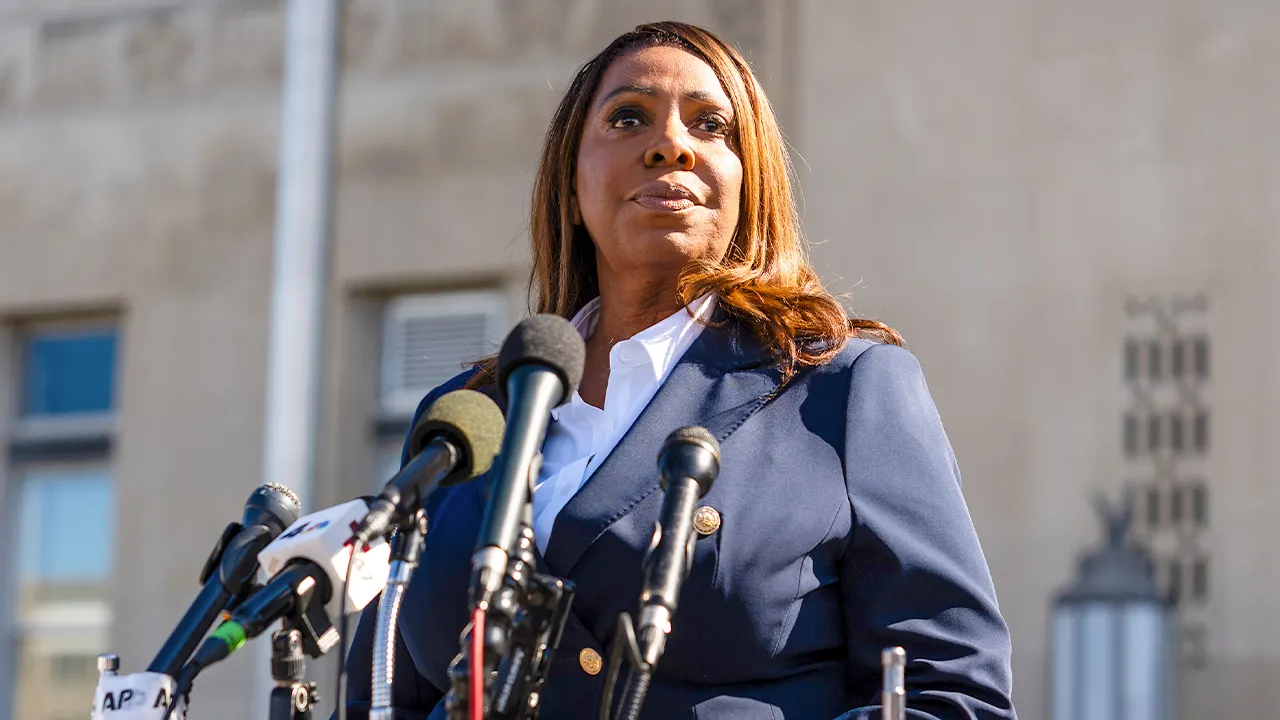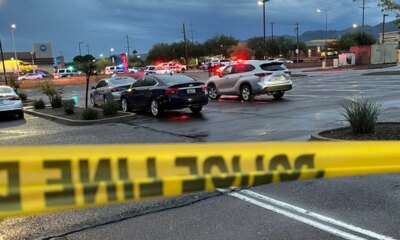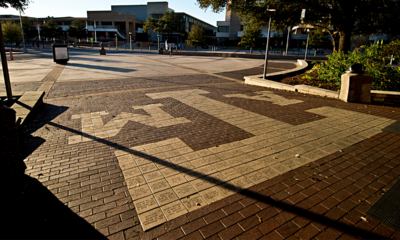Northeast
Knife-wielding man slashes NYPD officer in face with 14-inch blade, police shoot him dead in pursuit

NEWYou can now listen to Fox News articles!
A knife-wielding man was shot dead during a police pursuit in New York City after entering a police precinct and slashing an officer in the face with a 14-inch blade, authorities said Sunday.
The attack unfolded just before 5:30 a.m. at the 73rd Precinct in Brooklyn’s Brownsville neighborhood when a man entered the building through an employee entrance, NYPD Chief of Patrol Philip Rivera told reporters at a briefing.
When a female officer stopped the man and told him to go out and enter through the front door, the man pulled out “a large butcher knife” and slashed her in the face, Rivera said.
The female officer fought off the knife-wielding man, who then ran out through the back of the precinct. An officer used a taser as the man escaped, but the device was not effective in stopping him, Rivera said.
SIX PEOPLE SHOT, ONE SLASHED IN NYC VIOLENCE AFTER WEST INDIAN DAY PARADE ENDS MONDAY EVENING
Rivera said the individual used a 14-inch-long butcher knife to slash the officer in her face. (NYPD)
Several officers chased after the man, ordering him to drop the knife. The man did not comply with the officers’ commands, Rivera said.
A short time later, the man lunged at an officer with the knife. Several officers then opened fire on the knife-wielding man, striking him numerous times. He was pronounced dead at a local hospital.
Rivera said the female officer was in “good spirits” at a hospital. (FOX 5 New York WNYW)
Officers recovered the 14-inch blade at the scene.
NYPD OFFICER SHOT DURING CARJACKING BY CAREER CRIMINAL, ADAMS RIPS JUSTICE REFORMS
The officer who was slashed in the face was treated at a hospital, where she is recovering and in “good spirits,” Rivera said.
“This situation could have turned out very differently,” he said. “This is the risk that every NYPD officer faces every single day.”
Rivera said investigators had a tentative identification on the knife-wielding man, but could not immediately release it to the public.
Police said the incident remains under investigation.
Read the full article from Here

Vermont
Vermont’s ‘crack climbing mecca’ deep in the Northeast Kingdom gains popularity – VTDigger

Deep in the Northeast Kingdom lie the Kingdom Heritage Lands, 132,000 acres of former and current timberland conserved for public access since 1998. The remote and undeveloped area is mainly the domain of wildlife, logging trucks, hunters and snowmobilers.
Recently, however, increasing numbers of rock climbers have frequented a stunning band of chiseled granite towers set in the middle of the Kingdom Heritage Lands, at a cliff 30 minutes south of the Canadian border and on the northern edge of the Nulhegan basin.
“As soon as you reach the cliff, your jaw drops,” Mischa Tourin, executive director of the Climbing Resource Access Group of Vermont — or CRAG-VT — said last week. “It all is perfect 90-degree angles, like it was built by rock climbers with rock climbing in mind.”
Climbers first explored the cliff, known as Black Mountain (not to be mistaken for Black Mountain Natural Area in Dummerston), around 2005, but only visited it sporadically until it was added to the second edition of Vermont’s comprehensive outdoor climbing guidebook, “Vermont Rock,” in 2022.
Alongside the subsequent increase in use of the cliff, the nonprofit CRAG-VT has spent the past few years working with landowners and easement-holders to preserve access, including creating a climbing management plan and establishing rock climbing as an “acceptable form of recreation” on the Kingdom Heritage Lands.
As part of that effort, six weeks of trail work on the area’s rugged and steep approach trail have been completed over the last two years by NorthWoods Stewardship Center, with significant funding from the Vermont Department of Forests, Parks and Recreation.
According to Tourin, outdoor rock climbing in Vermont was, for a long time, defined by the schist that runs along the spine of the Green Mountains — a unique rock covered with tiny impressions, used by rock climbers as “holds.” In contrast, Black Mountain is made up of strong granite covered in “perfect” parallel cracks of varying sizes, Tourin said, which geologically has more in common with the White Mountains of New Hampshire or world-class climbing areas like Yosemite.
 100vw, 1200px”/><figcaption class=)
Those cracks, Tourin said, are very conducive to “traditional” climbing, where participants jam their hands and feet into the crack to move upward and place expansion gear — attached to a rope — in the cracks to catch a fall or help facilitate a descent.
“I think I feel comfortable saying that (Black Mountain) is the best place in the Northeast for crack climbing, as far as the number of crack climbs in one cliff,” the longtime climber and guide said. About 70 different routes have been established at the area, most of them of moderate or advanced difficulty.
However, reaching “Vermont’s premiere crack climbing mecca” can be quite the trek.
Black Mountain is located about a three-hour drive from Burlington, on the edge of Averill (population 21) and Lewis (population 0). Following a GPS will likely lead to a dead end, and a high-clearance vehicle is recommended.
The cliff is even a sizable distance from the Northeast Kingdom towns of St. Johnsbury (one hour and 30 minutes) or Newport (one hour), since users generally drive all the way up to the Canadian border in Norton before traveling 6.2 miles south on a slow, rocky power-line access road to reach Black Mountain’s parking area.
“It’s definitely far away,” Tourin said. “The last few times I’ve been there, it certainly seems like more folks in Canada have noticed that it’s a pretty good climbing resource because it’s only a couple miles south of the border.”
Before CRAG-VT’s involvement, the ordeal to reach the base of the cliff didn’t stop at the parking area. Up until a couple of years ago, visitors had to try and locate the access trail, which was steep, prone to erosion, often muddy and lined with prickly plants that latched onto any nearby pants leg.
As of last month, however, trail workers have fully established a sustainable approach trail that includes a welcome kiosk, 38 stone steps, four wooden ladders and 160 feet of retaining wall, a recent CRAG-VT newsletter explained.
 100vw, 1200px”/><figcaption class=)
“Next phases will continue base-of-cliff stabilization, assess more complex gully issues, and explore parking improvements,” the newsletter read. “This work moves us closer to a fully sustainable Black Mountain for years to come.”
According to Tourin, CRAG-VT’s work lies not only in securing access to climbing and stewarding cliffs but also in building community. To that end, the group held weekend member meetups titled Kingdom Climbing Weekend this year and last, renting out cottages at Quimby Country resort in Averill.
“We started it off maybe as a one-time thing to celebrate the start of (CRAG-VT’s) corridor manager agreement,” said Tourin, adding that most of those 40 participants wanted to return the next year to what he described as a “magical little family camp” on a lake.
“It’s a pretty great event and a pretty cool way to bring, I think, a little bit of money into the local community there,” he said.
While the remoteness of Black Mountain can be a draw, Tourin said it’s hard to gauge the future of the climbing area due to its location.
“It’s an amazing cliff,” he said. “I don’t know if it will ever be super crowded, just because it’s so far tucked away in the corner of the state, but it’s definitely a resource worth traveling to.”
Northeast
DHS demands Letitia James take action over New York’s refusal to honor ICE detainers

Trump tightens US immigration after DC shooting
Fox News’ Danamarie McNicholl and law professor John Yoo join ‘Fox News Live’ to break down the Trump administration’s tighter immigration guidelines after two National Guard members were shot and former President Joe Biden’s use of the autopen.
NEWYou can now listen to Fox News articles!
The Department of Homeland Security is calling on New York Attorney General Letita James to take action against New York City over its handling of illegal immigrants.
“New York City’s failure to honor ICE detainers has resulted in the release of 6,947 criminal illegal aliens since January 20. There are another 7,000 still in the custody of a New York jurisdiction with an active detainer,” DHS wrote on X.
“We are calling on NY Attorney General Letitia James to stop this dangerous derangement and commit to honoring our ICE arrest detainers. It’s common sense.”
In response to a request for comment, James’ office referred Fox News Digital to a letter that the state attorney general sent to Acting U.S. Immigration and Customs Enforcement (ICE) Director Todd Lyons in September. The letter from James was sent in response to a Sept. 10 message from Lyons. First, she stated that the New York Attorney General’s Office does not receive detainer requests “as we rarely take custody of individuals.”
ICE OFFICERS IN ILLINOIS TARGETED BY ILLEGAL IMMIGRANTS WHO USED ‘VEHICLES AS WEAPONS,’ OFFICIALS SAY
New York Attorney General Letita James speaks outside federal court in Norfolk, Va., on Friday, Oct. 24, 2025. (Eric Lee/Bloomberg via Getty Images)
She said “detainer requests are sent to a variety of entities within the State of New York, many of them local police department and local jails, each of which may have applicable laws and policies with respect to whether, to what degree, and under what circumstances to respond to federal detainer requests.”
“This creates a range of lawful practices that we cannot address in our capacity as the attorney general,” James’ letter reads.
On Monday, Lyons sent a fresh letter to James. In the letter, which was obtained by Fox News Digital, he included details about criminals in New York’s custody and examples of instances in which ICE was able to capture illegal immigrants accused of criminal activity.
“These are people who are not only in the country illegally but who have committed additional crimes, including heinous crimes like murder, rape, possession of child pornography, armed robbery, and many others. Virtually all Americans agree that people like this should be swiftly removed from the United States when they leave New York’s custody and not be returned to our streets to wreak havoc on law-abiding citizens,” Lyons wrote.
Federal immigration officers consult as they wait for respondents to depart from their hearings to conduct targeted detainments at U.S. immigration court in Manhattan, in New York City, Oct. 24, 2025. (David ‘Dee’ Delgado/Reuters)
RIOTERS ARRESTED AFTER ATTACKING ICE VEHICLES IN NEW YORK CITY; OFFICIALS SAY GROUP ORGANIZED ON SOCIAL MEDIA
One of the men mentioned in Lyons’ letter was Steven Daniel Henriquez Galicia, who was arrested by local authorities for attempted murder and criminal possession of a weapon. ICE later nabbed him in the Bronx, New York, and he remains in federal custody pending the outcome of immigration proceedings.
Vyacheslav Danilovich Kim, who was also featured in Lyons’ letter, was arrested by New York State Police for “use of a child less than 17 years of age in a sexual performance; rape in the second degree; disseminate indecent materials to minors; and patronizing a person for prostitution in the second degree of a person less than 15 years of age.”
Lyons said Kim was convicted in February 2013 and was sentenced to time served as well as five years’ probation. He also alleged that “Albany County and New York Probation refused to assist ICE in locating and/or arresting Kim.” However, ICE was able to arrest him in September 2024 as he was leaving an appointment with his probation officer. He was deported, according to the letter.
Another man mentioned in the letter was Anderson Smith Satuye-Martinez, an accused Crips gang member. The Department of Homeland Security (DHS) noted that Satuye-Martinez had a conviction for assault. He was arrested in August for criminal possession of a weapon and possession of a controlled substance. Despite having an active ICE detainer, Satuye-Martinez was released. However, ICE arrested him in September. He remains in federal custody.
Street vendors, many of whom are recent arrivals from West Africa, sell bags, watches, and jewelry along Canal Street on Dec. 1, 2025, in New York City. (Spencer Platt/Getty Images)
US ATTORNEY NARROWLY ESCAPES KNIFE ATTACK BY ILLEGAL IMMIGRANT, BLAMES NEW YORK’S SANCTUARY POLICIES
“Attorney General James and her fellow New York Sanctuary politicians are releasing murderers, terrorists, and sexual predators back into our neighborhoods and putting American lives at risk,” DHS Assistant Secretary Tricia McLaughlin said in a statement provided to Fox News Digital.
“We are calling on Letitia James to stop this dangerous derangement and commit to honoring the ICE arrest detainers of the more than 7,000 criminal illegal aliens in New York’s custody. It is common sense,” she added. “Criminal illegal aliens should not be released back onto our streets to terrorize more innocent Americans.”
McLaughlin also directed her ire at New York Gov. Kathy Hochul, writing in a post on X, “Under [Gov. Hochul] New York has refused to honor [ICE] detainers and RELEASED back onto New York’s streets 6,947 criminal illegal aliens since January 20.”
McLaughlin said that the crimes committed by the nearly 7,000 illegal immigrants include 29 homicides, 2,509 assaults, 207 sexual predatory offenses, 199 burglaries, 305 robberies, 392 dangerous drug offenses and 300 weapons offenses.
A spokesperson for Hochul called the claims “categorically false.”
“Since 2021, more than 1,500 individuals convicted of violent crimes have been turned over to federal immigration authorities following their time served at State prisons. Meanwhile, between January and November of this year, President Trump’s Department of Homeland Security failed to pick up 20 deportable felons that New York informed them would soon be released from prisons,” the spokesperson told Fox News Digital.
“If federal immigration authorities are serious about safety, they should continue to work with us to hold violent offenders accountable and stop wasting critical resources trying to separate families and deport immigrants who are making meaningful contributions to our communities.”
Police and U.S. Immigration and Customs Enforcement (ICE) officers stand guard as people gather near a General Services Administration (GSA) parking lot to prevent ICE from leaving for an immigration raid in the Manhattan borough of New York City, Nov. 29, 2025. (David Dee Delgado/Reuters)
CLICK HERE TO DOWNLOAD THE FOX NEWS APP
There are currently 7,113 illegal immigrants with active retainers in custody in New York, according to DHS. The individuals who are locked up are accused of committing 148 homicides, 717 assaults, 134 burglaries, 106 robberies, 235 dangerous drug offenses, 152 weapons offenses and 260 sexually predatory offenses.
ICE has faced challenges in New York City as it engages in a crackdown on illegal immigrants in Chinatown. The operation has sparked protests in the area for over a month.
On Saturday, police confirmed officers made multiple arrests during a protest in Lower Manhattan.
The NYPD told Fox News Digital that upon arriving at the scene, officers found agitators blocking the street and its exits at different locations. Video footage showed rioters pushing large potted plants in front of ICE vehicles, throwing trash at officers and screaming obscenities. They were also spotted hurling trash cans and recycling bins and pushing barricades against officers. Many were arrested after failing to comply with police demands that they disperse.
Fox News Digital’s Alexandra Koch and Fox News’ CB Cotton contributed to this report.
Read the full article from Here
Boston, MA
Some top spots for visiting with Santa around the Bay State this season

The rest of the world may be a wee bit jealous, because – based on his upcoming appearances – Santa absolutely loves the Bay State.
From cozy Back Bay parlors to Cape Cod seashore backdrops, the Big Guy (and the Mrs. most times) – will hop across Massachusetts until he returns to the North Pole for his Big Night. Consider these day trips/visits.
Santa in the Hub: Like all of us, Santa loves a true Back Bay vibe, which is why he not only has his own brownstone to kick off his boots in; he invites us all to visit him in his own city-based open house.
“Santa In the City,” takes place Dec.13 and Dec. 20 from noon to 6 p.m. in the brownstone directly across from Sweetgreen in Hynes Place. Stop by and be welcomed into the brownstone with classic Back Bay decor, holiday decorations (but of course), and Santa himself. Santa is happy to review wish lists, discuss gift choices and pose for photos. Santa will have his personal photographer there as well to capture your visit.
There ‘s bonus fun too: Right across the road at the Pru you’ll find Treehouse Brewing’s Winter Garden, as well as an immersive winter light show. (https://www.prudentialcenter.com/experiences/events/santa-in-the-city-2/)
Santa shares his posh holiday escape: You can’t blame Santa for needing some posh TLC pre-game so it’s no surprise he finds time to stay a night or two at The Dagny Boston (https://www.thedagnyboston.com/). Their holiday “Gilded Suite” is available to him – and to you – all holiday season.
The limited-time decor immerses you in holiday ambiance, with twinkling garlands and more. You’ll be greeted by Santa’s favorite scent – fresh baked cookies (from the Tradesman Coffee Shop). The lights of Boston via the impressive view out your window add the perfect touch.
Even better: if you book now, Santa promises to find time for a private visit in your suite. He’s not only bringing his love of all things Christmas, he’ll also come with stories to share, a smile for photos and Boston-themed gifts.
No time to stay over? No worries: Santa will appear in the hotel’s beautifully decorated lobby Dec. 18-22 where you can take your own photos or grab the hotel’s classic Polaroid to capture one. Times vary each day and can be found on the hotel website.
Santa likes grown-up holiday fun too : Which is why he applauds Cambridge’s Kimpton Marlowe (https://www.hotelmarlowe.com/) and its annual “Miracle” pop up bar.
In its eighth season, the pop up bar surrounds you in holiday cheer with lighted garlands, a crackling fire and festive decor.
And then there are the adult holiday cocktails, with names like Dancing Sugar Plums, Candy Cane Lane, Cherry Cherry Chocosaurus, Blitzen Barrel, Miracle Mouse and Coconut Hot Chocolate. Their “Nice and Naughty” shots are back too. Santa knows we don’t all imbibe though, so they’ve introduced new non-alcoholic options like the Snow Day Sipper, Silent Night and Mellow Mouse.
You’ll sip on season-themed cocktails served in cool glassware shaped like Santa’s head, a “Santa-saur” and a holiday unicorn. You can purchase the limited edition glassware for holiday gifts
Santa near the sand: As any Bay State lover knows, Santa understands a good escape to the Cape is always in order. That’s why you’ll find him at the Pelham House (https://www.pelhamhouseresort.com/) the beautiful resort set right on the beach in Dennisport. There, on Dec. 21, he’ll be up close and personal at his annual brunch.
Brunch takes place at the resort’s Rooftop Restaurant. While you’ll feel like you’re outside thanks to the floor to ceiling windows taking in the expansive seaside view, you’ll be snug since it is enclosed and heated in the winter,
Santa will be on hand to mingle, take gift requests, pose for photos and just plain celebrate with you. Reservations via the website are required.


-

 Politics5 days ago
Politics5 days agoTrump rips Somali community as federal agents reportedly eye Minnesota enforcement sweep
-
Ohio3 days ago
Who do the Ohio State Buckeyes hire as the next offensive coordinator?
-

 News5 days ago
News5 days agoTrump threatens strikes on any country he claims makes drugs for US
-

 World5 days ago
World5 days agoHonduras election council member accuses colleague of ‘intimidation’
-

 Texas1 day ago
Texas1 day agoTexas Tech football vs BYU live updates, start time, TV channel for Big 12 title
-

 Politics1 week ago
Politics1 week agoRep. Swalwell’s suit alleges abuse of power, adds to scrutiny of Trump official’s mortgage probes
-

 Alaska20 hours ago
Alaska20 hours agoHowling Mat-Su winds leave thousands without power
-

 Politics5 days ago
Politics5 days agoTrump highlights comments by ‘Obama sycophant’ Eric Holder, continues pressing Senate GOP to nix filibuster
























